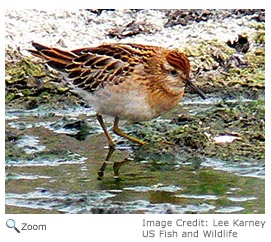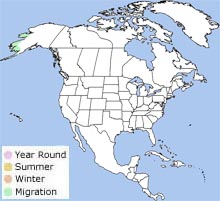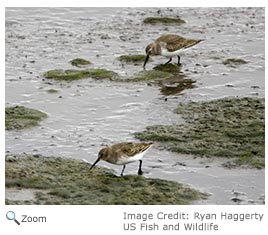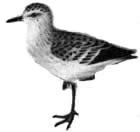Description
 The sharp-tailed sandpiper is about eight inches in length. Its back, wings, and tail are rusty-brown, black, and white. It has a light cream to tan lower chest and belly and a reddish-brown cap. Its bill is sharp, long, and black. It has long, white to gray legs and a sharp tail. The sharp-tailed sandpiper is about eight inches in length. Its back, wings, and tail are rusty-brown, black, and white. It has a light cream to tan lower chest and belly and a reddish-brown cap. Its bill is sharp, long, and black. It has long, white to gray legs and a sharp tail.
Range
 The sharp-tailed sandpiper breeds on the Siberian tundra and winters in Australia and New Zealand. Migrating birds appear in Alaska and in small numbers along the West Coast in the fall and, less often, inland and on the East Coast. The sharp-tailed sandpiper breeds on the Siberian tundra and winters in Australia and New Zealand. Migrating birds appear in Alaska and in small numbers along the West Coast in the fall and, less often, inland and on the East Coast.
Habitat
 The sharp-tailed sandpiper can be found in grassy areas of coastal marshes and on tidal flats. The sharp-tailed sandpiper can be found in grassy areas of coastal marshes and on tidal flats.
|
|
DietThe sharp-tailed sandpiper eats mosquito larvae. It also eats mollusks and crustaceans. Life CycleThe male sharp-tailed sandpiper mates with more than one female. The female build a nest of grass on the tundra. She lays an average of four eggs. The chicks hatch in 19-23 days. They leave the nest after a day or so and begin to feed themselves. They fledge when they are 18-21 days old.
Behavior  A Eurasian species, the sharp-tailed sandpiper appears in North America mainly after the end of the nesting season. Most of the birds recorded in North America are the young of the year. A Eurasian species, the sharp-tailed sandpiper appears in North America mainly after the end of the nesting season. Most of the birds recorded in North America are the young of the year. |



 The sharp-tailed sandpiper breeds on the Siberian tundra and winters in Australia and New Zealand. Migrating birds appear in Alaska and in small numbers along the West Coast in the fall and, less often, inland and on the East Coast.
The sharp-tailed sandpiper breeds on the Siberian tundra and winters in Australia and New Zealand. Migrating birds appear in Alaska and in small numbers along the West Coast in the fall and, less often, inland and on the East Coast. 
